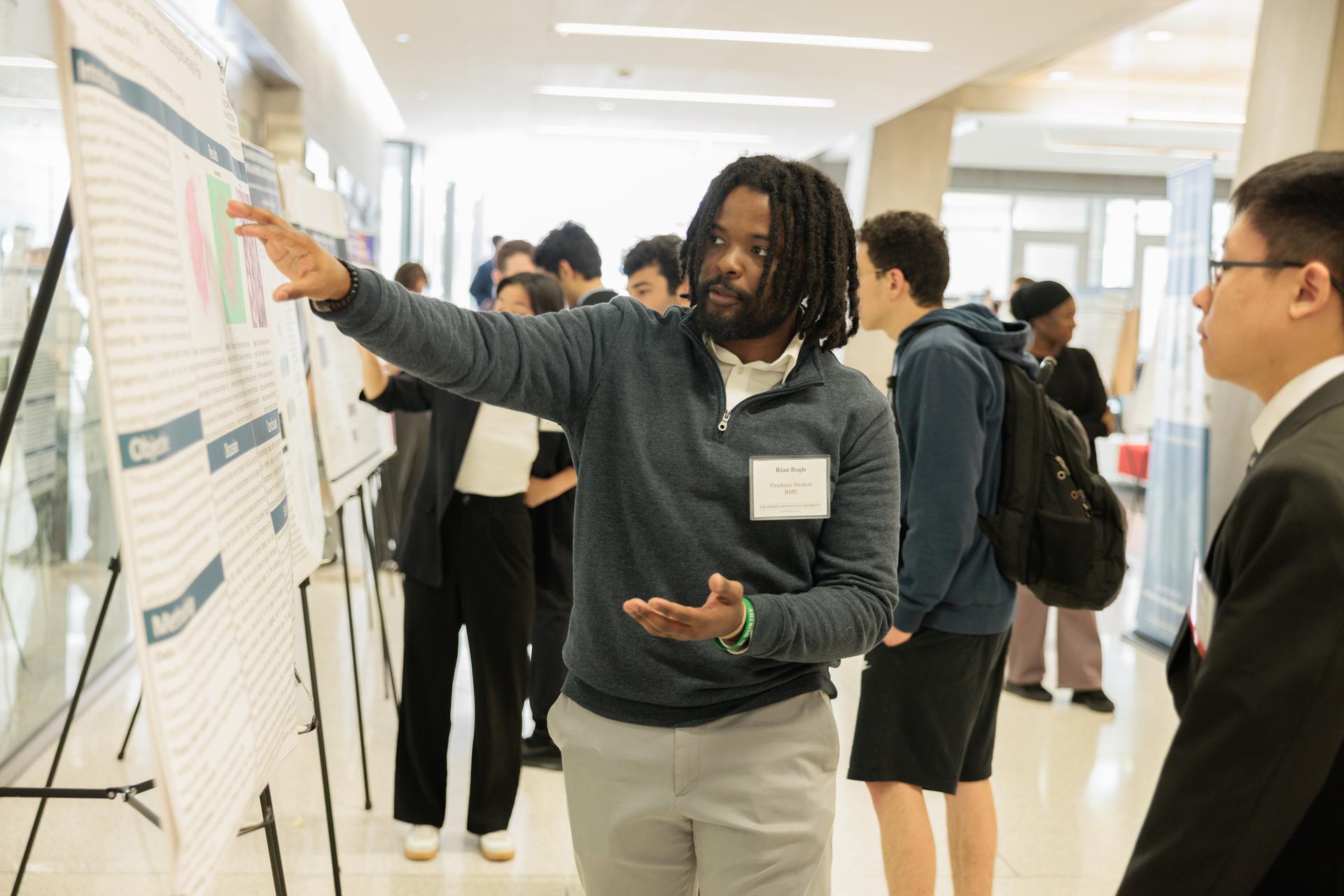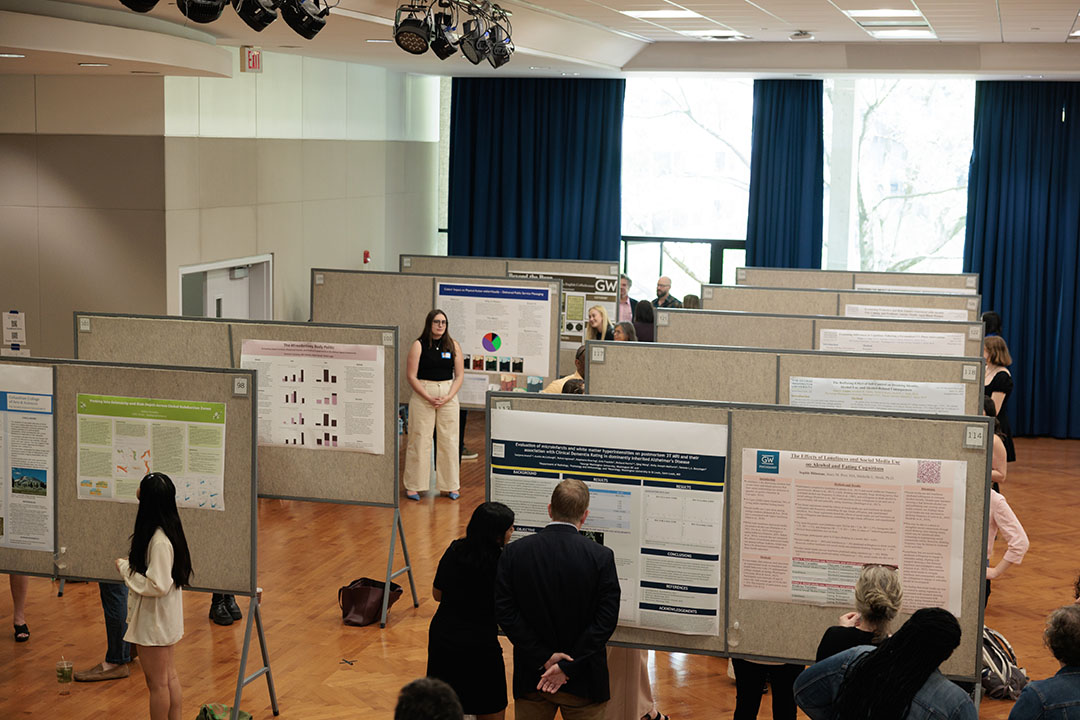At-home mushroom cultivation isn’t for the faint of heart. Spore kits are easily contaminated, buckets or boxes of dirt take up space and ideal fungal growth conditions—high moisture, darkness—aren’t necessarily ideal for human living spaces. (Nor is the smell.) So a hydroponic grow box on display at the George Washington University School of Engineering and Applied Science Student Research & Development and Senior Design Showcase last week could be a game changer. Small enough to fit on a kitchen counter, with an elegant, faceted front that looks a little like a museum display case, the unit housed a net of mycelium that will soon sprout into tasty oyster mushrooms. No dank basement required.
The box was a capstone project for a team of senior electrical and computer engineering students including Alicia Ha, who presented it Friday in the lower level of Science and Engineering Hall (SEH). Theirs was one of 117 projects on display at the annual showcase, many of them undergraduate capstone or final-level group projects in their degree areas.
Ha and her teammates in Assistant Professor of Electrical and Computer Engineering Amir Aslani’s class designed, programmed and assembled the unit themselves, using GW Engineering resources like the Adaptive Devices and Microsystems Lab to create experimental prototypes and finally a working grow box. To see their concept move from idea to reality was astonishing, Ha said.
“I think our ‘Aha’ moment was about a month and a half ago when we put the whole box together,” she said. “Suddenly everything turned on and all these parts were working in real life.”
Nearby, senior biomedical engineering students Amy Fehr, Josh Luu, Margaret McKenzie and Salvador Parot displayed a modified NeuroSky EEG headset for use by seizure patients. A certain pattern of spikes in brainwave activity signals an oncoming seizure, warning the wearer in time to pull over their car or notify onlookers.
“It's been actually really fun to be able to finally talk about it, because we’ve been working on it for so long,” Fehr said. “It's been so many meetings and so much work, and now it’s finally culminated into something we can actually show people.”
The showcase also provided a fun opportunity for role reversal, the students said, as professors they spent four years learning from treated them as peers with something to teach. (Coincidentally, all four members of the group will continue to pursue advanced degrees at GW.)
Upstairs, displays of non-capstone projects and ongoing research ringed the SEH atrium. Artin Yousefi, a master’s student in computer science, developed an AI chatbot to help smokers quit, working with subject matter experts from GW’s Milken Institute School of Public Health to ensure that its responses adhered to the latest medical guidelines.
Yousefi, whose background is in cognitive neuroscience, said one of the greatest challenges with any AI chatbot is to make it flexible and responsive without being prone to breaking, or gaining new “information” from adversarial users that then informs its responses. (Bots are prone to repeating conspiracy theories, for instance.) The chatbot Yousefi and his team developed is particularly resistant to this kind of manipulation and still able to produce creative, even playful responses—like a playlist of Taylor Swift songs to keep an aspiring quitter on track.
Yousefi said the R&D showcase provided a great opportunity to meet and share knowledge with scholars from outside his department. “I’ve met a lot of people who are interested and knowledgeable about these topics,” he said.
Some projects’ impact was as much social as technical. Eliot Hunter, a junior majoring in mechanical engineering, worked with graduate student Naomia Suggs-Brigety and Associate Professor of Mechanical and Aerospace Engineering Saniya LeBlanc on a project bringing energy literacy and community garden space to students in Anacostia.
The historically Black neighborhood in Southeast Washington, D.C., is also historically underfunded and underserved. Part of Hunter’s work included mapping the neighborhood’s inconsistent public transit access and sparse electric vehicle (EV) charging stations in contrast to wealthier areas of the city. A more equitable future depends in part on citizens’ consciousness of energy and sustainability: where their energy comes from, how it’s spent and who else is spending it. It also depends on understanding the benefits of sustainability. The community garden that Hunter and Suggs-Brigety are revitalizing is one example of the urban green spaces that United Nations specialists call “invaluable” for maintaining public health and mitigating climate change.
With older students, aged nine to 12, Hunter and Suggs-Brigety conducted more advanced teaching sessions on photosynthesis and the interplay of energy and sustainability. With younger students aged five to eight, they focused on the basics: what in your house uses energy? How much? Where does it come from?
Hunter said the showcase was an opportunity to remember why he and Suggs-Brigety did this work in the first place. He’d loved working with the students, but in the months since the sessions ended he’d been in the academic weeds as he gathered, mapped and analyzed data about D.C. energy use. As friends and colleagues stopped by, Hunter said he started looking forward to the project’s future.
“Explaining it really helps me put it all together and remember what I'm doing it for,” Hunter said. “It's easy to get disconnected, and it's really nice to be able to share this with other people and to continue it next summer.”




